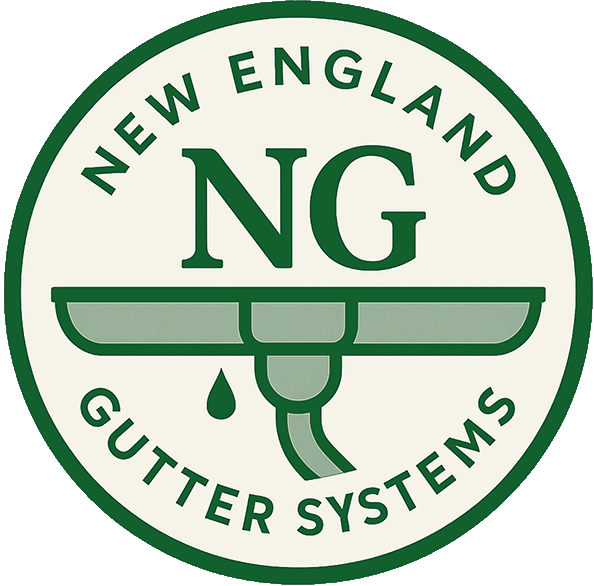Commercial Buildings in New Hampshire Need Heavy Duty
Large Capacity Seamless Gutters
That Are Designed For New England Weather

The Importance of choosing
High-Capacity Seamless Gutter Systems
for Commercial & Large Roofs
in New Hampshire
If you've ever watched a waterfall pour off the edge of a roof during a storm, you know what happens when gutters can't keep up. In New Hampshire, with its heavy snow, ice, and rain, oversized gutter systems aren't a luxury they're a necessity for many buildings.
New Hampshire's Challenging Climate Reality:
Scientists predict that annual average precipitation will increase 14-20% and that the number of extreme storms will increase threefold, resulting in a greater risk of flooding. New Hampshire has been experiencing more storms with sleet and freezing rain, which could cut down on snow totals and create messy travel. These changing weather patterns make proper gutter sizing more critical than ever for protecting your property investment.
Why Oversized Gutters Are Essential for Large Roofs
Commercial buildings, metal warehouses, schools, and even large residential homes can produce massive amounts of runoff during a storm. Standard 5" or 6" gutters just can't handle the volume, leading to water damage, ice dams, and erosion.
New Hampshire's Precipitation Patterns:
The state experiences frequent precipitation due to its location along several preferred storm tracks. Storms will be less frequent but more severe in intensity, and there will be longer dry periods between storms. This means when storms hit, they often deliver intense rainfall that can quickly overwhelm undersized gutters.
Common Problems with Standard 5" and 6" Gutters
Overflowing water that splashes onto siding, ice building up along the eaves, and water pooling around the foundation are all signs your system is undersized for the job.
Ice Dam Formation in NH:
New Hampshire's freeze-thaw cycles create perfect conditions for ice dams. When snow melts during the day and refreezes at night, small gutters become completely blocked with ice, forcing water to back up under shingles and into your building.
How High-Capacity Systems Prevent Overflow & Damage
A bigger gutter profile, paired with larger downspouts, moves water away faster—before it has a chance to cause trouble. Think of it like upgrading from a garden hose to a fire hydrant.
Storm Surge Protection:
With New Hampshire experiencing more intense rainfall events, high-capacity gutters provide the extra volume needed to handle sudden downpours without overflowing. This is especially important during spring snowmelt combined with rain—a common occurrence that can produce massive water volumes.
Understanding High-Capacity Gutter Options
When it's time to upgrade, you've got choices—each suited for different building types and styles.
8" K-Style Gutters – The Heavy-Duty Choice
These oversized versions of the classic K-style gutter hold 5.3 gallons of water per linear foot compared to 6" models which hold 2 gallons of water per linear foot, making them ideal for steep-pitched roofs and large surface areas.
Perfect for NH Mountain Regions:
In areas like the White Mountains and other high-elevation locations in New Hampshire, rapid snowmelt and heavy rainfall make the extra capacity of 8" K-style gutters essential for protecting buildings from water damage.
Commercial Box Gutters for Maximum Flow
Box gutters are custom-fabricated to blend seamlessly into the roofline, especially on flat or low-slope roofs. They can be built to nearly any size, perfect for handling extreme runoff.
Ideal for NH's Commercial Buildings:
Many of New Hampshire's industrial and commercial buildings have large, flat roofs that collect enormous amounts of water during storms. Box gutters can be sized specifically to handle the calculated runoff from these expansive surfaces.
Half-Round Gutters for Style and Performance
Half-round gutters aren't just for historic homes—they're also efficient at moving water quickly, with smooth interiors that resist debris buildup.
Heritage Building Protection:
New Hampshire has many historic buildings that require period-appropriate gutters. Half-round systems provide the authentic look while offering superior performance during the state's harsh weather conditions.
When to Choose a High-Capacity Gutter System
You might not think about your gutters until they're overflowing, but there are clear signs you need to size up.
Warning Signs You Need an Upgrade
Water spilling over during normal rain
Ice dams forming every winter
Staining or rot along fascia boards
Foundation cracks or basement leaks
Icicle formation along gutters Common in NH's freeze thaw cycles
Water damage in basements after spring snowmelt A frequent problem in New Hampshire homes
Gutters pulling away from the house Often caused by ice and snow loads
Building Types That Benefit Most
Commercial warehouses
Schools and municipal buildings
Metal-roof structures
Historic properties with wide roof overhangs
Ski lodges and mountain cabins Common in NH's recreational areas
Manufacturing facilities Prevalent throughout the state's industrial corridors
Agricultural buildings Barns and farm structures dealing with large roof areas
Benefits of Installing High-Capacity Gutters in New Hampshire
Bigger gutters aren't just about moving more water they're about protecting your property investment.
Handles Heavy Snow and Ice Loads
In NH, snow melt combined with a sudden rainstorm can overwhelm small gutters in minutes. High-capacity systems stay ahead of the flow.
Winter Weather Resilience:
Frequent snowstorms in New England should keep snow lovers happy, but they also create challenges for gutter systems. High-capacity gutters are built with reinforced hangers and structural integrity to handle the weight of accumulated snow and ice without sagging or breaking.
Spring Snowmelt Management:
New Hampshire typically experiences rapid snowmelt events in March and April. When combined with spring rains, this creates peak water flow conditions that only properly sized gutters can handle effectively.
Protects Foundations and Siding
By moving water further away from the building, you avoid costly structural repairs down the road.
Basement Protection:
New Hampshire's clay and rocky soils don't always drain well, making proper water diversion critical. High-capacity gutters with adequate downspout spacing prevent the foundation issues that are common in older NH buildings.
Lowers Long-Term Maintenance Costs
Oversized gutters clog less often and require fewer cleanings, saving you time and money.
Debris Management:
New Hampshire's abundant trees (the state is 84% forested) means gutters face constant challenges from falling leaves, pine needles, and branches. Larger gutters handle this debris better without becoming completely blocked.
Reduced Ice Dam Maintenance:
Properly sized gutters reduce ice dam formation, eliminating the need for costly ice dam removal services that many NH property owners face each winter.
Weather-Resistant Materials:
We use materials specifically chosen for New Hampshire's climate, including thermal expansion considerations for the state's wide temperature swings from summer highs to winter lows.
Secure Mounting for Harsh Weather
Reinforced hangers and heavy-gauge materials keep your system stable, even in high winds and heavy snow.
Cost Considerations and Value Over Time
A larger system costs more upfront, but the payoff is in protection and reduced repair bills.
Why Bigger Systems Pay for Themselves
Avoiding one major water damage repair can offset the cost difference between standard and oversized gutters.
Insurance Considerations:
Many New Hampshire property owners have seen insurance premiums rise due to increased weather-related claims. Proper gutter systems can help prevent claims and may qualify for discounts with some insurers.
Property Value Protection:
With New Hampshire experiencing various billion-dollar weather events including flooding, severe storms, and winter storms, proper water management systems like high-capacity gutters help maintain property values.
Comparing Materials: Aluminum, Copper, and Steel
Aluminum offers affordability and rust resistance, copper delivers unmatched longevity, and steel provides extra strength for industrial applications.
Material Performance in NH Climate:
Aluminum:
Handles freeze-thaw cycles well and resists salt corrosion from winter road treatments
Copper:
Develops protective patina that performs excellently in New Hampshire's variable climate
Steel: Best choice for extreme snow load areas in northern New Hampshire
Choosing the Right Contractor for the Job
Installation quality matters as much as gutter size.
Questions to Ask Before Hiring
Do you offer seamless commercial gutters?
What warranty do you provide?
Can I see past commercial projects?
Are you familiar with New Hampshire building codes and snow load requirements?
Do you have experience with ice dam prevention in this climate?
Can you provide references from similar projects in New Hampshire?
Red Flags to Watch Out For
Vague estimates without measurements
Limited experience with large-capacity systems
No local references
Unfamiliarity with New Hampshire's specific weather challenges
No discussion of snow load capacity or ice dam prevention
Reluctance to provide local project references
FAQ: High-Capacity Gutters in New Hampshire
What size gutters are best for large roofs?
For most commercial and large residential roofs, 8" K-style or custom box gutters are best. In New Hampshire, we often recommend going one size larger than calculated minimums due to the state's intense storm patterns and freeze-thaw cycles.
Do 8" K-style gutters work for residential homes?
Yes, especially for large or steep-pitched roofs and roofs with solar panels, multi-level roofs, and roofs with lots of peaks and valleys prone to overflow. In New Hampshire, homes with metal roofs or those in high-snowfall areas particularly benefit from oversized gutters.
How long does a commercial gutter installation take?
Most jobs are completed in 1–3 days depending on size and complexity. In New Hampshire, we schedule installations during favorable weather windows and may need additional time for snow load reinforcement requirements.

